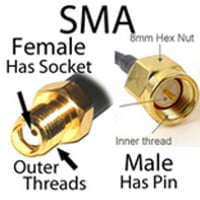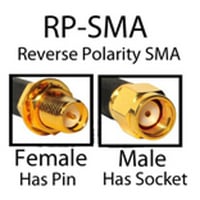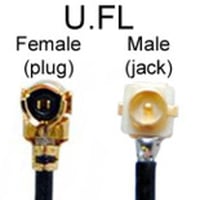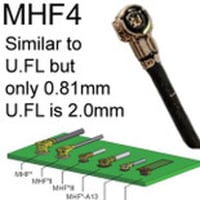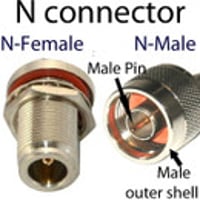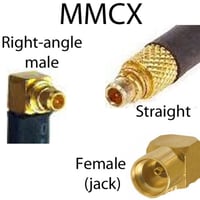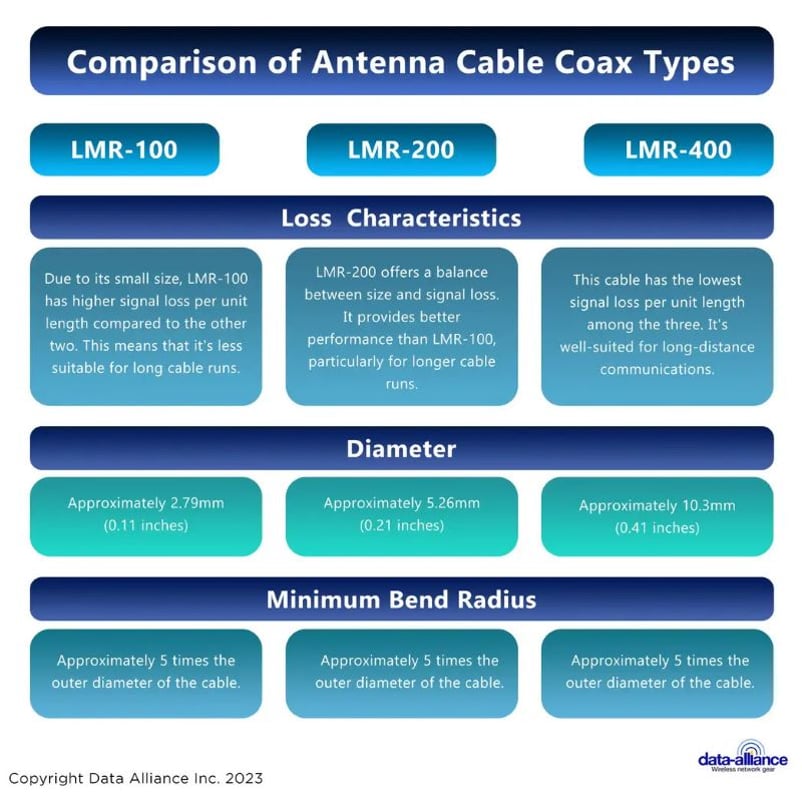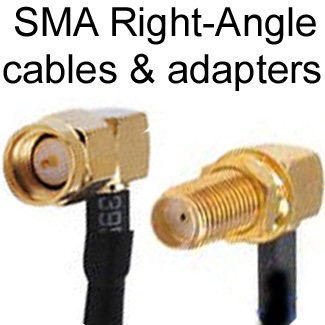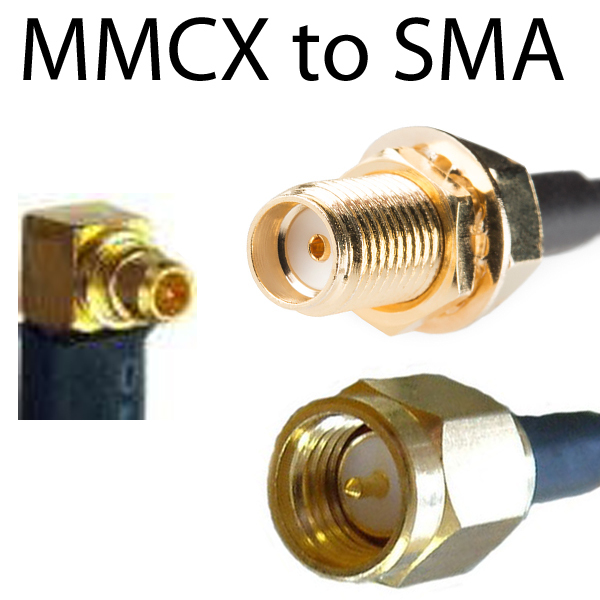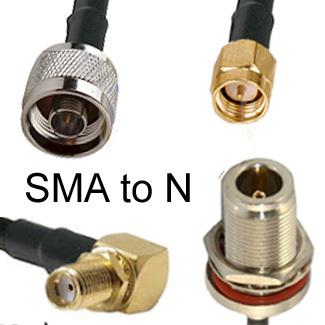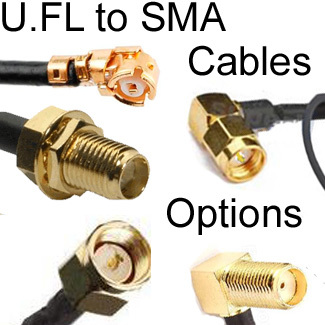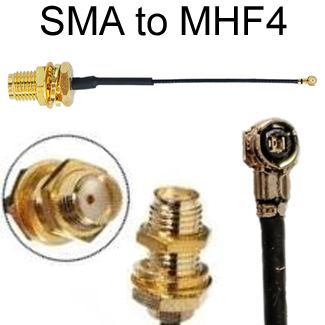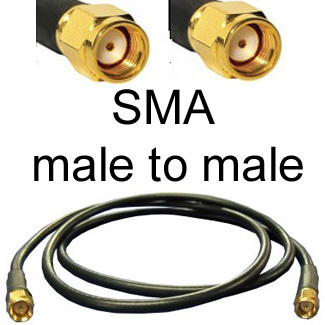SMA Cables & Adapters
SMA Antenna Cables to all RF Connector Types
SMA (SubMiniature version A) cables and adapters are widely used in the world of wireless communication and networking. These connectors offer a reliable and efficient solution for various applications, making them a popular choice among professionals and enthusiasts alike.
SMA Connectors Options for Intrusion Protection / Weatherproofing
SMA-Female: Special versions for Intrusion Protection: Weatherproofing / Waterproofing
Data Alliance offers various SMA-female connector options to enable weatherproofing, intrusion protection and waterproofing. Options for the female SMA connector include:
- An elongated threaded section, to pass through thicker enclosure walls, a panel or casing.
- O-ring embedded in the bulkhead (also known as the flange). For this version, the bulkhead has a larger diameter of 11mm, versus 8mm for the more standard bulkhead diameter.
- The two options above can be combined on the same connector.
- Right-angled connectors: All of the above options can be provided as a right-angle SMA connector.
SMA-female Connector Bulkhead / Flange Diameter. The wider bulkhead diameter enables a more secure fit and sealing of the connector, in a port of a case or enclosure. The flange acts as the mounting surface that ensures proper alignment and attachment of the connector to the enclosure or casing. Naturally, the wider 11mm flange with an embedded O-ring enables the most secure protection against intrusion of dust, dirt, and water.
Enhanced Sealing with Embedded O-Rings and Loose O-Rings: As important as selecting the right connector for your project is ensuring the reliable connection and longevity of your equipment by protecting it against external factors such as water, dirt, and dust. One essential aspect of achieving this protection lies in the sealing of connectors.
Embedded O-Rings, also known as captive O-rings, are designed to fit precisely within the connector interface, providing a seamless and secure seal. These O-rings are integrated directly into the connector, eliminating the risk of misalignment or damage during installation. The snug fit ensures that the O-ring stays in place, preventing any gaps that could compromise the seal against moisture, dust, or other contaminants. With Embedded O-Rings, connectors achieve a higher level of protection and reliability, making them an excellent choice for demanding environments.
Loose (Donut Shape) O-Rings: On the other hand, Loose O-rings, or donut-shaped O-rings, are separate components that users manually place around the connector interface before coupling. They remain a cost-effective solution for applications where the sealing requirements are not as stringent.
Compatible Wireless Technologies for Data Alliance's SMA Cables and Adapters
- IoT wireless protocols including BlueTooth, RFID, LoRa, NB-IoT, ZigBee, LTE-m.
- Cellular Networks: LTE, GSM, ISM. From 2G to 5G, SMA connectors and adapters are used in base stations, repeaters, and other cellular infrastructure equipment.
- Wi-Fi (IEEE 802.11): WiFi & WiMax networks: 802.11N, AC, G, A, B. 900MHz, 2.4GHz & 5GHz applications' SMA adapters are prevalent in Wi-Fi setups, ensuring compatibility between routers, antennas, and boosters.
- Bluetooth: Some high-performance Bluetooth devices, especially those used for industrial applications, use SMA connectors and might require adapters for connectivity with other systems.
- GPS: High-precision GPS receivers, especially those used in research and defense, often come with SMA connectors. Adapters are used to interface these receivers with antennas and other systems.
- Satellite Radio: Devices like satellite radios, which receive signals from orbiting satellites, employ SMA connectors and adapters for their high-frequency needs.
- Any other application with wireless antennas with frequency between 0 and 18GHz, and 50 Ohms impedance-matching.
Torque Ratings
The torque applied when connecting SMA connectors and adapters is pivotal:
- Recommended Torque: Typically, the advised torque rating for SMA adapters falls between 5 to 10 inch-pounds.
- Over-Torqueing: Exceeding this can lead to damage, such as deformed mating surfaces, which can subsequently cause increased VSWR and potential connector damage.
- Under-Torqueing: A suboptimal torque might not offer a robust connection, leading to potential signal loss and reduced performance.
Applications
Wireless Antennas: SMA cables and adapters are commonly used in wireless antennas for both indoor and outdoor applications. They ensure a secure connection between the antenna and the wireless device, providing stable signal transmission and reception.
Wi-Fi Routers and Access Points: These connectors are essential components in Wi-Fi routers and access points, enabling seamless connectivity for a wide range of devices within a network. Internet of Things (IoT) Devices: SMA connectors are the connector of choice for many IoT devices, facilitating reliable data transfer between sensors and other smart devices.
Radio Frequency (RF) Modules: These connectors are extensively utilized in RF modules for data transmission and communication between electronic devices.
Key Features
- Broad Frequency Range: SMA cables and adapters are capable of functioning across a diverse frequency range, usually from DC to 18 GHz.
- High Durability: Crafted for longevity, they're designed to endure repetitive mating's.
- Low VSWR: Their low Voltage Standing Wave Ratio ensures minimal signal reflection.
- Impedance Matching: Most SMA adapters come with a standard 50-ohm impedance, crucial for maximum power transfer.
Advantages
Versatility: SMA connectors come in a variety of configurations, allowing them to be used with different types of cables, antennas, and devices. Their versatility makes them suitable for a wide range of applications, offering compatibility and ease of integration.
Secure Connection: The threaded coupling mechanism of SMA connectors provides a secure and reliable connection, reducing the risk of signal loss or interference.
High Performance: SMA connectors are known for their excellent electrical performance, maintaining low signal loss and impedance matching, which are essential for efficient data transfer and reliable communication.
Whether it's for antennas, routers, or RF modules, SMA connectors continue to play a crucial role in advancing modern wireless technologies.
SMA-Female: SMA connectors are widely used for their reliable performance and compatibility with many coaxial cables. Data Alliance's SMA-female connectors are built with high-quality materials, ensuring durability and efficient signal transmission.
SMA connectors are favored for their screw coupling mechanism which is reliable and vibration resistant. Standard brass connectors are also relatively inexpensive.
Standard SMA connectors vs. Reverse Polarity SMA (RP-SMA) connectors:

- Standard SMA: The male has a central pin and a hex nut barrel with internal threading. The female has a central receptacle and an outer casing with external threads.
- Reverse Polarity SMA (RP-SMA): The male has a central pin where the SMA-male has a receptacle. Similarly, the female has a central pin rather than a receptacle. Standard SMA and RP-SMA connectors are not compatible. This reversing is done on some equipment where there is a danger that the user might damage the connectors wile coupling due to their position or repeated mating.
Coaxial Cable Types compatible with SMA Cables:
- LMR-100, LMR-200, and LMR-400: LMR (Low Loss Microwave Radio) cables are double shielded and offer lower signal loss and better performance than standard RG cables. LMR-100 is used for shorter cable runs. LMR-200 and LMR-400 are suitable for longer cable runs and higher-frequency applications.
- RG-58/U: This is a common coaxial cable type for SMA connectors. It's suitable for shorter cable runs and relatively low-frequency applications.
- RG-174/U: This is a thinner and more flexible coaxial cable, suitable for applications where flexibility is important.
Frequency Range: The choice of SMA cable depends on the frequency of the signals you are working with. Different SMA cables have different frequency ranges, so ensure that your chosen cable can support your application's frequency requirements.
The SMA connector (Sub-Miniature Version A) is a semi-precision RF coaxial connector with a screwing coupling feature. The female connector has a threaded barrel with a density of 36 threads per inch. The male connector has a hex nut that fits securely around the female barrel for a tight coupling. This coupling is fairly secure and has an outstanding mechanical durability. Connectors are made out of stainless steel or brass, coated with nickel or gold around the contacts.
SMA connectors have an impedance of 50 Ohms used from DC to 18GHz. Both male and female connectors use polytetrafluoroethylene (PTFE) dielectric. The connectors have a coupling cycle of 500 times, which can only be achieved by applying the recommended torque while coupling.
Common applications of SMA connectors and cables:
- Wi-Fi antennas, LTE, GSM & CDMA antennas, 433MHz antennas
- Base stations
- Hand-held radio and telephone antennas
- Machine to machine communications
- Industrial Internet of Things
- Radio astronomy
SMA connectors are not compatible with the common, commercially available Type F coaxial connector. Type F connectors look similar but are of slightly different size and will not pair with SMA or RP-SMA connectors without an adapter.
Industrial IoT (Internet of Things) Applications
SMA cables are commonly used in industrial IoT (Internet of Things) applications for connecting various devices and sensors to data acquisition systems, controllers, and communication modules. SMA connectors are known for their durability and reliability, making them suitable for harsh industrial environments. Here's some information about SMA cables in the context of Industrial IoT:
-
Durability: Industrial IoT applications often involve exposure to harsh environmental conditions. SMA connectors are known for their ruggedness, making them suitable for industrial use. Look for SMA cables with robust and weather-resistant construction.
-
Shielding: Ensure that the SMA cables you select have proper shielding to minimize electromagnetic interference (EMI) and maintain signal integrity, which is crucial for reliable data transmission in industrial settings.
-
Customization: Depending on your specific requirements, you may need custom lengths and configurations of SMA cables. Data Alliance offers customization services to meet your exact needs.
-
Connector Compatibility: Ensure that the SMA connectors on your cables are compatible with the devices and sensors you are connecting. SMA connectors should match the gender and type (SMA or RP-SMA) required by your equipment.
-
Installation: Proper cable installation and routing are essential in industrial environments. Make sure to secure and protect your SMA cables to prevent damage from mechanical stress or environmental factors.
-
Budget: Consider your budget when selecting SMA cables. While high-quality cables are essential for reliable performance, you should balance cost with your specific application requirements.
-
Testing: After installation, it's essential to conduct signal integrity and cable performance tests to ensure that your SMA cables meet the required specifications and provide reliable data communication.
When selecting SMA cables for Industrial IoT applications, consult with your IoT system integrator or Data Alliance as your cable specialist, to ensure that you choose the right cables and connectors to meet your specific needs. Proper cable selection and installation are crucial for the success and reliability of your industrial IoT system.
In the vast realm of radio-frequency (RF) and microwave systems, SMA (SubMiniature version A) adapters play a crucial role. These seemingly unassuming components, which enable the connection between different SMA connector types, are at the heart of many technological systems we rely on today.

